The events for the 2018 Reebok CrossFit Games Regionals have been announced, and Friday will feature two historic CrossFit workouts.
Event 1 is the Triple 3, which kicked off Friday morning at the 2014 Reebok CrossFit Games. It is also the event that gave us a classic moment: A struggling Rich Froning running/walking to a 37th-place event finish (with a time of 38:31) before going on to win his fourth straight Games title.
Event 2 is Linda, which was first featured on CrossFit.com on July 5, 2003, and later became affectionately known as the “Three Bars of Death.” Linda has been programmed a total of 31 times on CrossFit.com, while Triple 3 has only been programmed once, on July 24, 2014, during the Games.
Nearly 5,000 athletes have logged a score for Triple 3 on BTWB since the event was seen at the Games in 2014. Over 15,000 have logged scores for Linda. These results include athletes with a wide range of abilities from several thousand CrossFit affiliates worldwide. Below, we’ll take a look at the data to give us an idea of what to expect at Regionals.
Event 1: Triple 3
The Regional version of Triple 3 is a little different: Regionals athletes will be suffering through 3 miles on the Assault AirRunner rather than the street outside the StubHub Center. The AirRunner is a self-powered treadmill with a reputation for being much harder than normal running. This should slow the run times down quite a bit.
Overall, 81 percent of the male results and 63 percent of the female results logged on BTWB are as Rx’d. This is pretty similar to the numbers we saw for a lot of the Open workouts, suggesting Triple 3 is similarly accessible to the average CrossFit athlete.
Looking at the numbers, the 49-minute Regionals time cap seems pretty generous. Eighty percent of the Rx’d men and 50 percent of the Rx’d women on BTWB were able to finish the workout in under 49 minutes. Based on this, we should expect very few athletes to be saved by the bell on this workout, and we all get to wait for the AirRunner to slowly suck a full 3 miles of life out of each and every competitor.
At the 2014 Games, Rob Forte won the event for the men with a time of 33:03. Kristin Holte took the top spot for the women with 36:07. From the BTWB data, times of 34:43 for men and 38:20 for women put athletes in the 99th percentile. Rich Froning’s time from 2014 would have put him outside the top 10 percent of athletes worldwide.
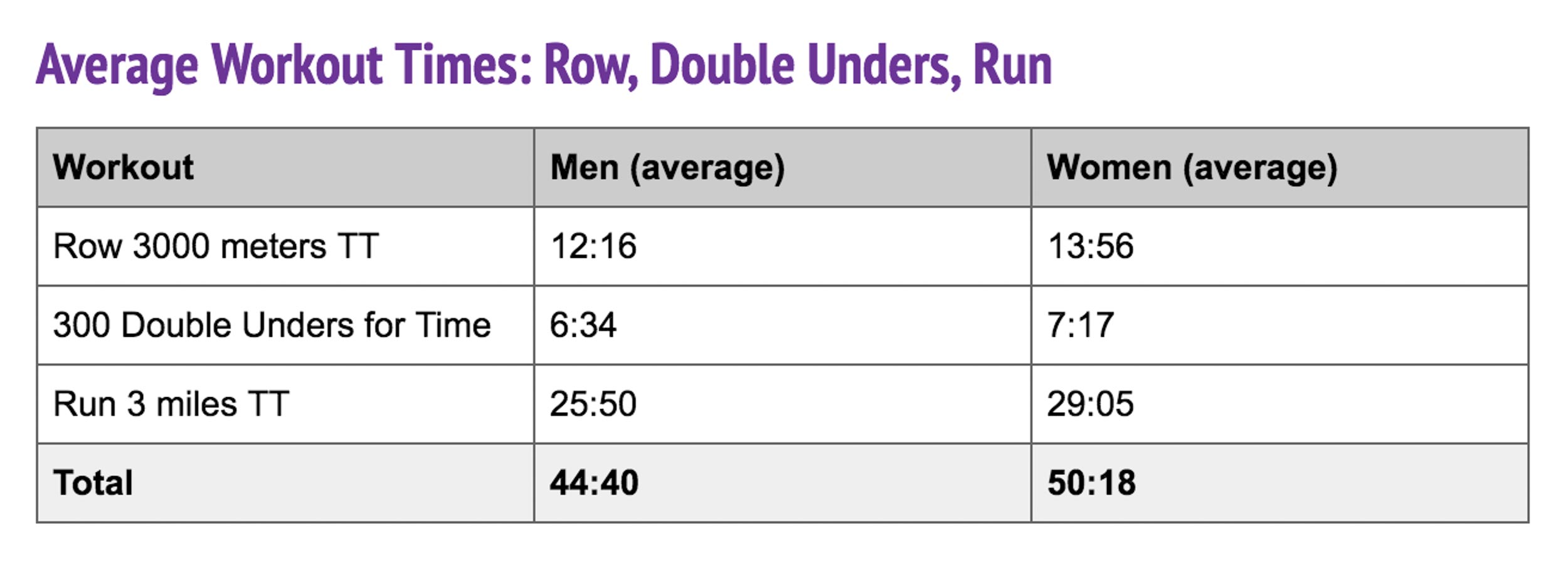
Of the three parts to this workout, the run generally takes longer than the row and the double-unders combined. The average time for a 3-mile run outdoors is 25:50 for men and 29:05 for women—not enough masochists have posted 3-mile times on the AirRunner to give us statistically significant data. The average time for a 3,000-m row is 12:16 for men and 13:56 for women. The average time for 300 double-unders is 6:34 for men and 7:17 for women. Keep in mind that these average times were logged when athletes did each piece separately. We would expect some drop-off in the double-under and run times due to the extra fatigue that comes from combining all three pieces.
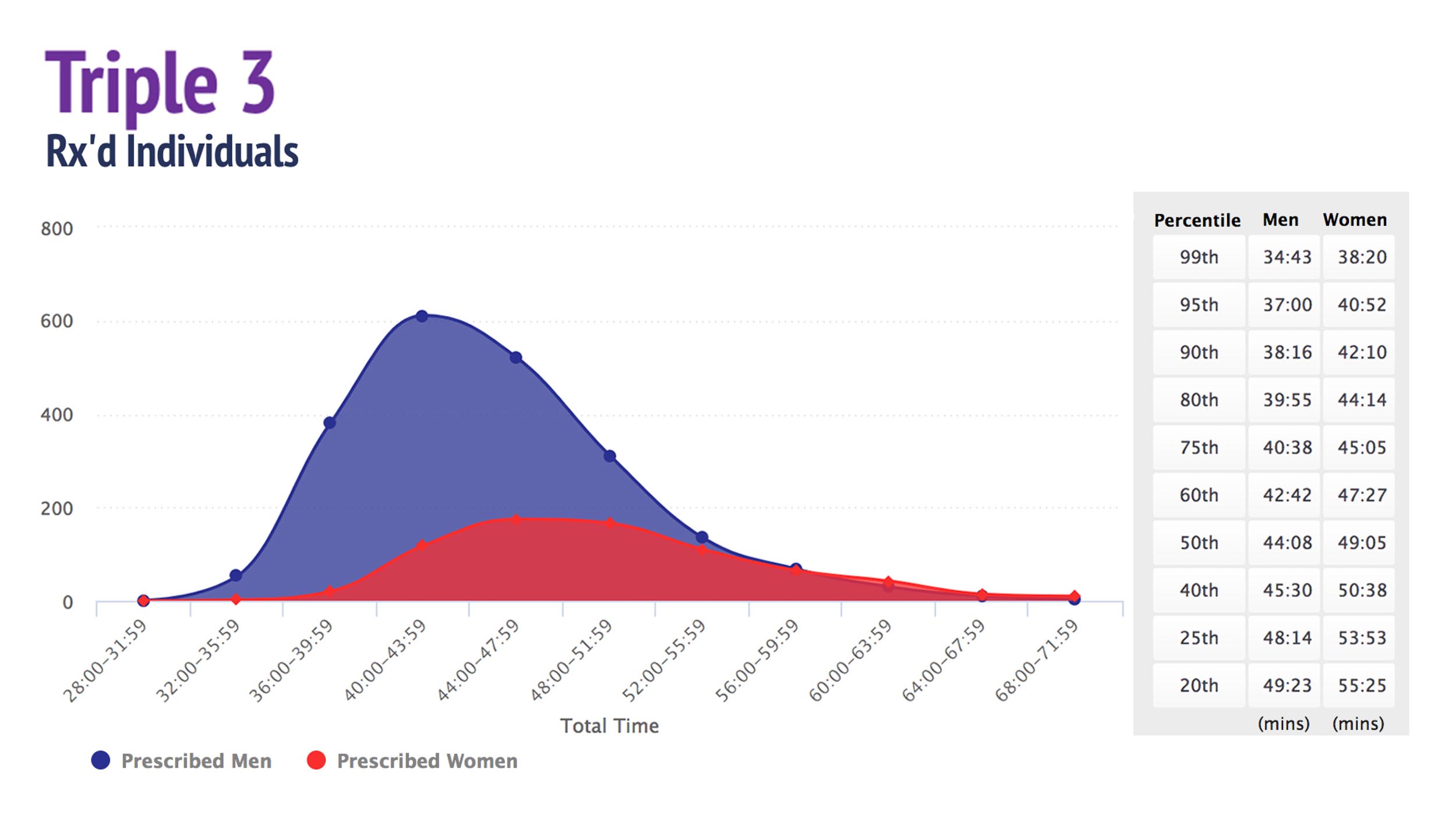
Event 2: Linda
The Regional version of Linda is also different from the traditional benchmark. The loading for the original version is 1.5x body weight for the deadlift, 1x body weight for the bench press and 0.75x body weight for the clean. Prescribed loads based on body weight are pretty rare in CrossFit benchmark workouts, and the Regional version prescribes fixed loads instead.
The weights appear to be based on roughly a 195-lb. male and 145-lb. female (except the women’s bench-press load is 10 lb. lower at 135 lb.). This is in line with historical average body weights for male and female Games athletes.
With fixed weights, heavier athletes will be performing a relatively easier version of the workout, while lighter athletes will be going heavier than normal. This could make it tougher for some lighter athletes to get the work finished under the time cap.
Linda is quite a bit more popular than Triple 3, with more than three times as many scores logged on BTWB. When looking at scaling rates of the original Linda, we found that about 42 percent of the men performed a scaled version. For the women however, over 90 percent of the results were scaled. This huge disparity suggests that repping out body-weight bench presses is more challenging for the women.
To shed some light on this disparity, we can look at 1RM-bench-press data. Below are selected 1RM percentiles for men and women on BTWB, looking at over 85,000 results.
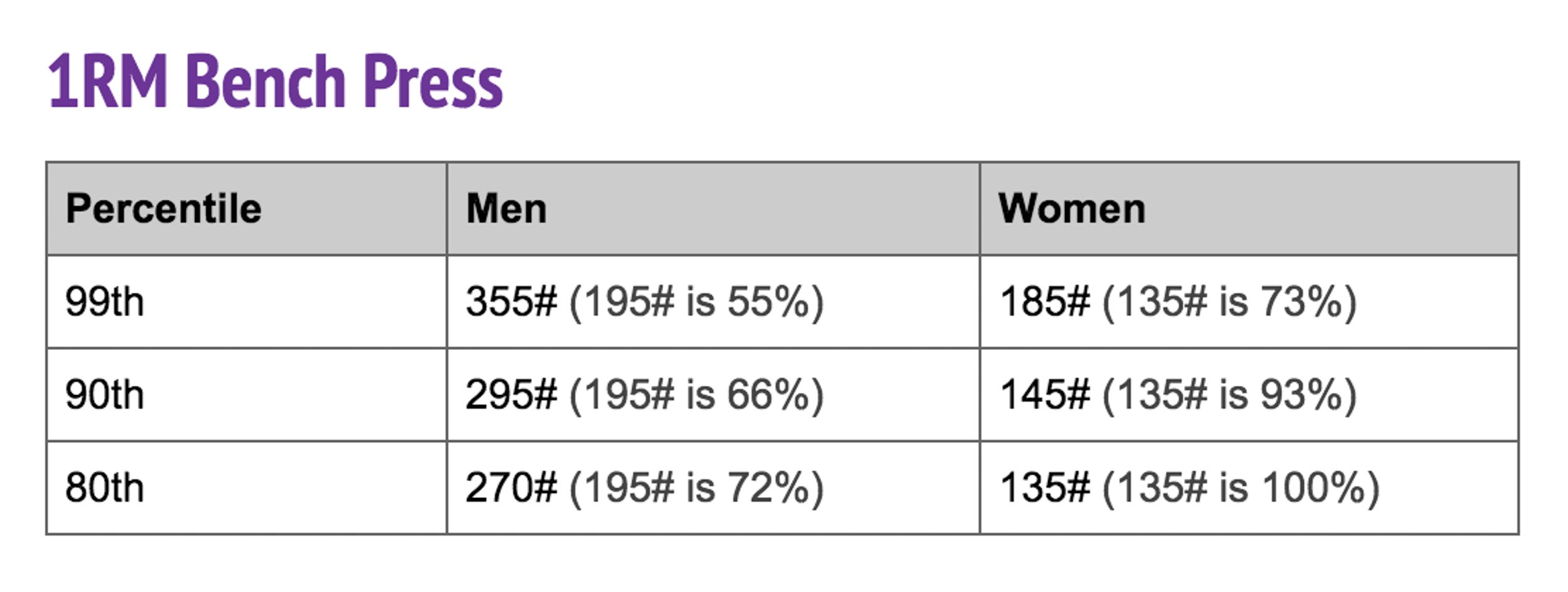
For a man in the 80th percentile, the prescribed bench-press weight on Regional Linda is 72 percent of his 1RM. For a woman in the 80th percentile, the prescribed bench-press weight is 100 percent of her 1RM. Needless to say, it’s not easy to perform 55 reps of your 1RM during the course of a workout. For comparison, a woman would have to be in the 99th percentile for her 1RM bench press in order to achieve a percentage similar to that of an 80th-percentile man.
To say it a different way, almost 80 percent of women can’t even perform 1 rep of bench press at 135 lb. For the men, only 25 percent can’t perform 1 rep of 195 lb.
There are still some disparities between genders on the weights of the deadlift and the squat clean, but nowhere near what we see on the bench press. Below are the same numbers for the deadlift and squat clean.

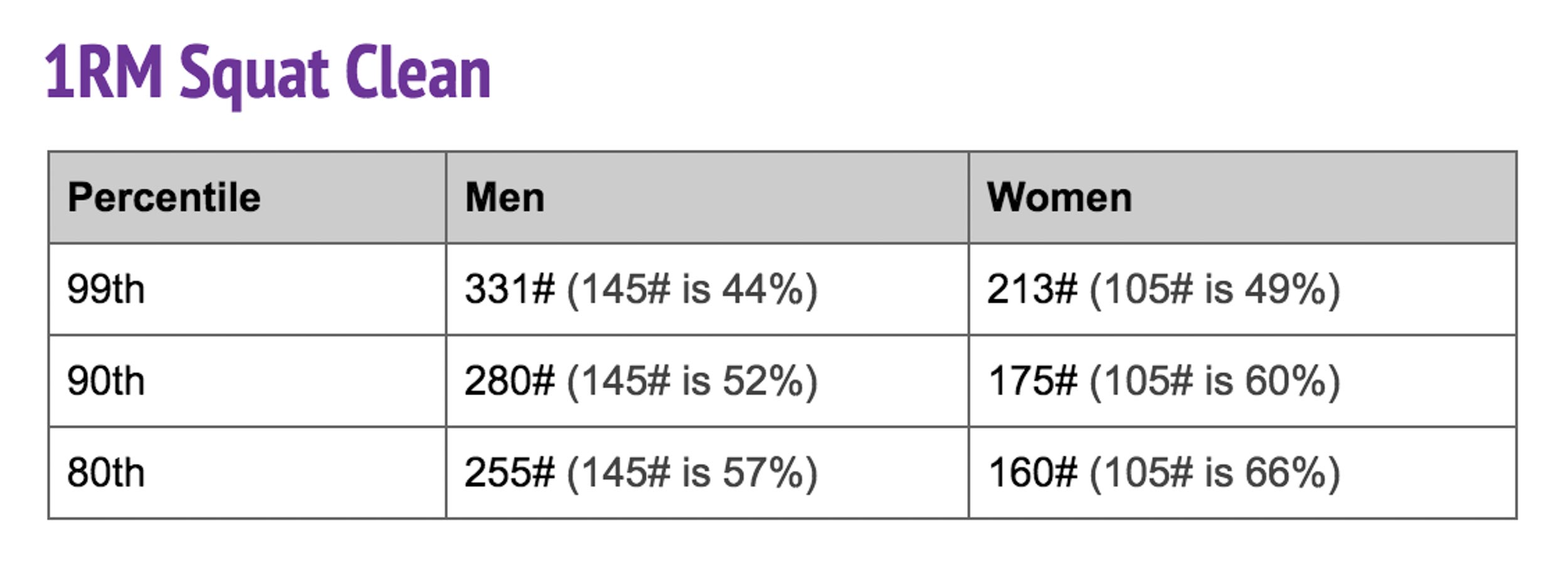
We expect the time cap on Linda to be much tighter than Triple 3’s cap, especially for the women. Less than 10 percent of the Rx’d men and less than 5 percent of the Rx’d women who have logged on BTWB finished Linda in under 17 minutes.
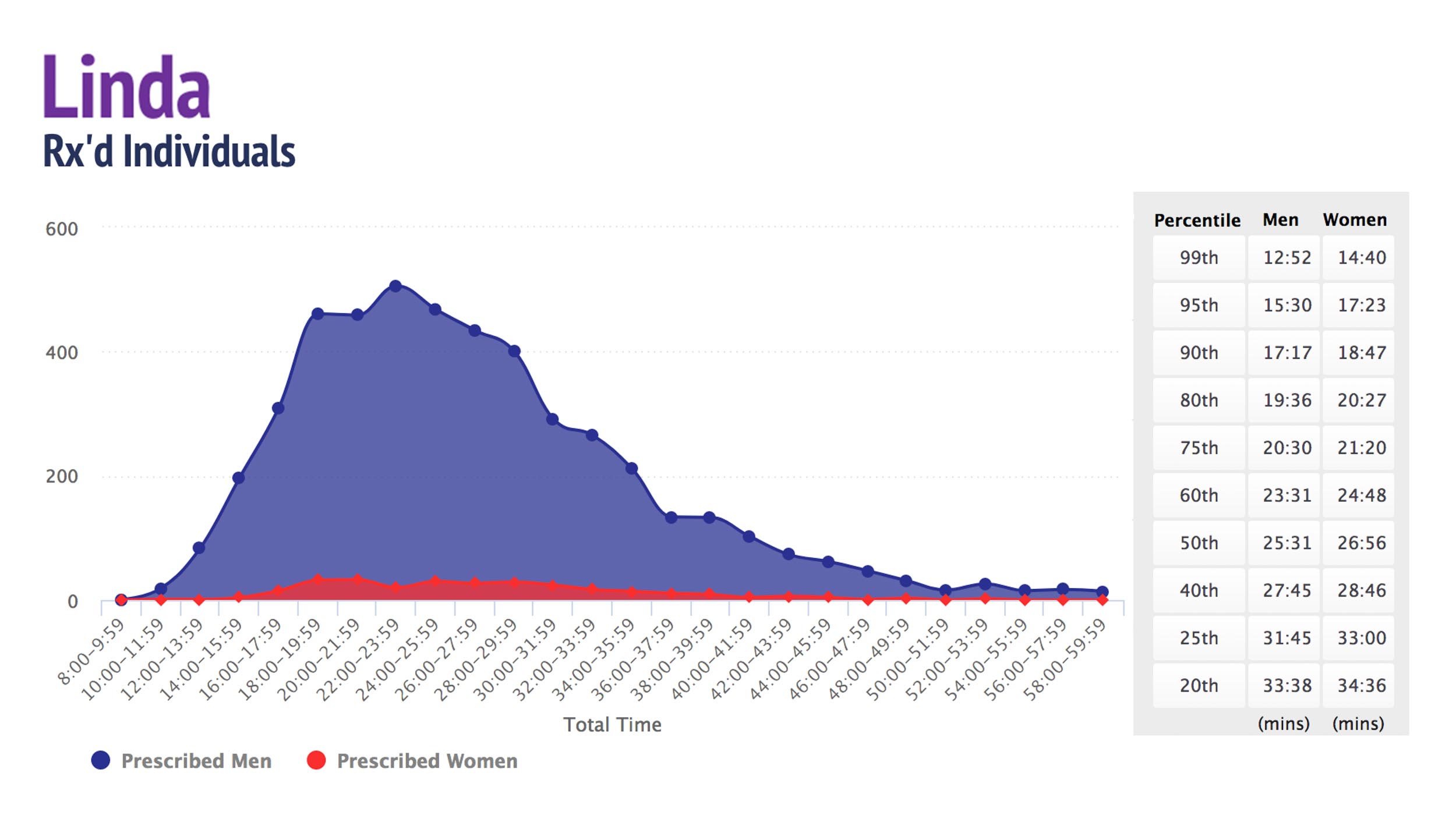
The 99th-percentile times for Linda on BTWB are 12:52 for men and 15:20 for women. We expect the top times at Regionals to be faster than these.
Scaling Strategies
If you’re thinking about attacking these workouts yourself, you might need to consider scaling one or both of them.
Triple 3 is the more accessible of the two, but we still see that about 27 percent of BTWB users choose to scale it. If you have double-unders and are willing to devote upwards of an hour to the effort, go for it! A shorter option that still gives a taste of the original would be the less-alliteratively named Double 2, consisting of a 2,000-m row, 200 double-unders and a 2-mile run. If you don’t have double-unders yet but you still want to take a crack at the full workout, consider substituting 600 single-unders.
Linda is tough to do as prescribed. There are 55 reps of each movement, so the weights need to be quite a bit lower than your deadlift, bench and squat-clean 1RMs. A good scaling option for men: the Regional Rx’d women’s weights (220-lb. deadlift, 135-lb. bench press and 105-lb. clean). For women needing to scale, a 155-lb. deadlift, 95-lb. bench press and 75-lb. squat clean would be a good option to consider.
About the Author: Jonathan Kinnick, CF-L3, is a co-founder and chief analytics officer (CAO) at BTWB. He is the owner of CrossFit Kinnick in Upland, California, and he sits on the CrossFit Certification Board and the CrossFit RRG Board of Directors. He has taught economics at California State Polytechnic University—Pomona since 2007, and he has coached individual, team, teen and masters athletes to the CrossFit Games. He enjoys using his statistics and econometrics background to publish data-driven articles on the intersection of training, lifestyle, health and aging.
BTWB is the official CrossFit® workout-tracking app. Log, plan and analyze your WODs with friends at your CrossFit® box and around the world. All plans come with a 30-day free trial.